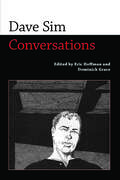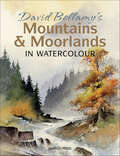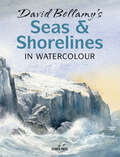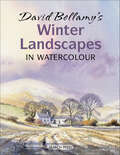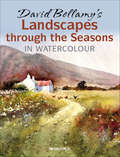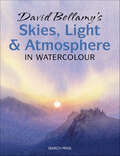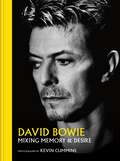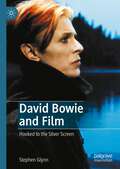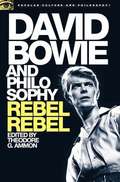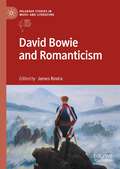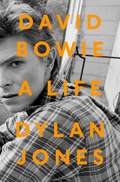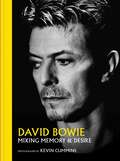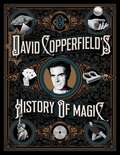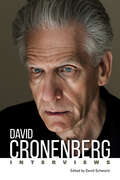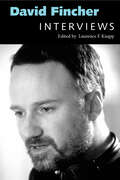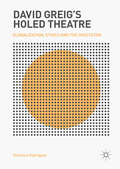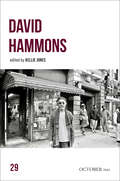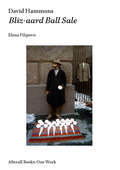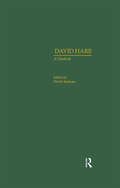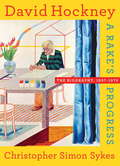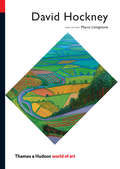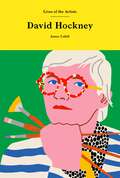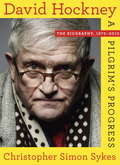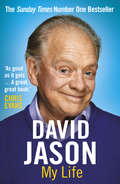- Table View
- List View
Dave Sim: Conversations (Conversations with Comic Artists Series)
by Eric Hoffman Dominick GraceIn 1977, Dave Sim (b. 1956) began to self-publish Cerebus, one of the earliest and most significant independent comics, which ran for 300 issues and ended, as Sim had planned from early on, in 2004. Over the run of the comic, Sim used it as a springboard to explore not only the potential of the comics medium but also many of the core assumptions of Western society. Through it he analyzed politics, the dynamics of love, religion, and, most controversially, the influence of feminism—which Sim believes has had a negative impact on society. Moreover, Sim inserted himself squarely into the comic as Cerebus's creator, thereby inviting criticism not only of the creation, but also of the creator. What few interviews Sim gave often pushed the limits of what an interview might be in much the same way that Cerebus pushed the limits of what a comic might be. In interviews Sim is generous, expansive, provocative, and sometimes even antagonistic. Regardless of mood, he is always insightful and fascinating. His discursive style is not conducive to the sound bite or to easy summary. Many of these interviews have been out of print for years. And, while the interviews range from very general, career-spanning explorations of his complex work and ideas, to tightly focused discussions on specific details of Cerebus, all the interviews contained herein are engaging and revealing.
David Bellamy's Mountains & Moorlands in Watercolour
by David BellamyRenowned watercolourist, David Bellamy shares his passion for painting mountains and moorlands in this inspiring and practical book. There is advice on finding subjects and painting trees, water, rocks, crags and buildings, as well as an in-depth look at the painting techniques required. David's extensive travels mean that mountains and moorlands from all over the world appear in the paintings.
David Bellamy's Seas & Shorelines in Watercolour
by David BellamyLearn to paint the varied and dramatic coastlines of the world, with this guide from the expert teacher—includes four step-by-step demonstrations.Renowned watercolourist David Bellamy shares his passion for painting seas and shorelines in this inspiring and practical book. His extensive travels mean that seas and shorelines from all over the world appear in the paintings—and you can benefit from his knowledge and experience with advice on:finding subjects and painting the different moods of the searocks, crags and cliffsadding figures and animals into your artworksAlso included is an in-depth look at the painting and sketching techniques required, so painters at every level can start creating their own beautiful seascapes.
David Bellamy's Winter Landscapes
by David BellamyThis is David Bellamy’s favourite time for being out sketching, often in watercolour. In this book he explains the challenges and joys of capturing winter subjects, from how to achieve rapid pencil sketches in less than perfect conditions to painting in watercolour on the spot. Snow completely changes the landscape, simplifying it for the artist, creating marvellous opportunities for reflected light and subtle use of exciting colours. The book begins with the stunning warm colours of late autumn, then moves into the second section covering winter scenes without snow. The following deep mid-winter section shows you how to tackle snow scenes with various types of snow conditions, before we move on to the final section covering early spring. Also covered is gearing up for working outdoors in winter, techniques for rendering hoar frost on trees, misty and atmospheric effects, injecting rogue colours to add excitement to your work, how to tackle a variety of tree branches for different species, depicting light branches against dark backgrounds, altering the composition to suit your needs, and so much more. For those who really don’t wish to venture out, even on the mildest of winter days, there is a whole host of examples of winter landscapes to help you tackle this fascinating time of year. A DVD entitled Winter Landscapes in Watercolour has been produced as a companion to this book, and is available from David's website www.davidbellamy.co.uk or from APV Fiilms at www.apvfilms.com
David Bellamy’s Landscapes through the Seasons in Watercolour
by David BellamyMaster artist and best-selling author David Bellamy shares with you his techniques, ideas and approach to painting his beloved landscape throughout the year. A revised and expanded edition of David Bellamy's Winter Landscapes in Watercolour, David looks at each season in detail and explores the challenges and surprises they present to the landscape artist.Also covered are learning techniques for seasonal effects such as rendering hoar frost on trees; misty and atmospheric effects; injecting rogue colours to add excitement to your work; how to tackle a variety of tree branches for different species; depicting light branches against dark backgrounds; altering the composition to suit your needs, and so much more.
David Bellamy’s Skies, Light and Atmosphere in Watercolour
by David BellamyIn this second book in a series covering elements of the landscape, renowned watercolourist, David Bellamy shows how to paint skies, light and atmosphere and how choices involving these three key elements can affect a painting. Starting with skies, David Bellamy covers basic techniques, composition, clouds, special effects like silver linings, sunsets and shafts of light, and much more, then there is a step by step dramatic sky demonstration. Next comes light, with plenty of advice including warm and cool light, using glazes, cast shadows, light from different directions, painting the sun and reflected light, followed by a step by step demonstration featuring strong light and shadow. The atmosphere section covers haze and mist, fog, mountains in cloud, smoke and steam, rain, storms and tranquil moods, and is followed by an atmospheric step by step painting of a waterfall. David Bellamy’s extensive travels and much admired painting style ensure that there are plenty of beautiful, inspiring paintings of skies, light and atmosphere throughout the book.
David Bowie Mixing Memory & Desire: Photographs by Kevin Cummins
by Kevin Cummins"AS ICONIC PHOTOGRAPHER, ADVENTUROUS FAN AND INSIDEREYE-WITNESS, KEVIN CUMMINS HAS ALWAYS BEEN WHERE THE CULTURALACTION IS. MIXING MEMORY & DESIRE WILL MAKE YOU SEE DAVID BOWIE INA SURPRISING AND STIMULATING NEW WAY." -PAUL MORLEY"DAVID BOWIE WAS ON A CREATIVE JOURNEY THROUGH MUSIC,FASHION AND ART. A JOURNEY UNPARALLELED IN POPULAR CULTURE.WHAT A PRIVILEGE IT IS FOR US THAT KEVIN CUMMINS WAS THERE TOCAPTURE THIS JOURNEY. HIS WONDERFUL BOOK SHOWS US EXACTLYWHY BOWIE WAS SO UNIQUE." -NOEL GALLAGHER"KEVIN BRILLIANTLY CAPTURES THE ESSENCE OF THE GREAT MAN INTHESE REMARKABLE PHOTOGRAPHS. CUMMINS IS SO ADEPT AT BREAKINGDOWN THE BARRIER OF THE CAMERA, YOU SENSE BOWIE IS COMPLETELYAT EASE WHEN THEY WORKED TOGETHER" -GOLDIEThe career of celebrated photographer Kevin Cummins began on 29th June 1973 when, as a nineteen-year-old photography student, he photographed David Bowie. That image is now in the renowned photography collection of the V&A Museum and marked the beginning of Kevin Cummins' four-decade-long visual chronicle of David Bowie's remarkable career. David Bowie: Mixing Memory & Desire includes some of the best portraits of Bowie ever taken, the majority of which have never been published until now. From those legendary Bowie gigs in the early 1970s, through to a poignant image taken outside his apartment in New York in 2016, Cummins has captured the many faces of Bowie and created a book that is essential for Bowie fans everywhere.
David Bowie and Film: Hooked to the Silver Screen
by Stephen GlynnThis book constitutes the first monograph dedicated to an academic analysis of David Bowie’s appearances in film. Through close textual analysis together with production and reception histories, Bowie’s ‘silver screen’ career is explored in full. The book covers performance documentaries such as Ziggy Stardust and the Spiders from Mars, star vehicles ranging from the eulogised The Man Who Fell to Earth to the excoriated Just a Gigolo, plus roles from the horror chic of The Hunger and cult fantasy of Labyrinth to the valiant high-brow Baal and vainglorious high-budget Absolute Beginners, ending with Bowie as Bowie in Bandslam and others as ‘Bowie’ in Velvet Goldmine and Stardust. Alongside showing his willingness to experiment (and at times fail) across a variety of genres, this study investigates Bowie’s performative style that, while struggling to accommodate the requirements of cinematic realism, fits more harmoniously with alternative production codes and aesthetics. More broadly, by exploring the commercial, socio-cultural and ideological significance of Bowie on film, the book demonstrates how notions of gender, sexuality and identity formation, plus commodity and cultural capital, function and fluctuate in contemporary society.
David Bowie and Philosophy: Rebel, Rebel
by Theodore G. AmmonAmong the topics explored in David Bowie and Philosophy are the nature of Bowie as an institution; Bowie's work in many platforms, including movies and TV; Bowie's spanning of low and high art, and his relation to Warhol; the influence of Buddhism and Kabuki theater; the recurring theme of Bowie as a space alien, including "Space Oddity" and The Man Who Fell to Earth; the dystopian element in Bowie's thinking, displayed in "1984" and the album Outside; the role of fashion in Bowie's creativity; personal identity as preserved over various divergent personae; the aesthetics of theatrical rock and glam rock; Bowie's public identification with bisexuality and his influence within the LGBTQ community.Pervasive themes in Bowie's output include change, time, apocalypse, dancing, mind-body dualism, and spirituality. In the dualistic universe that undergirds his lyrics, body consistently wins over mind, but body is nevertheless on the hook of moral responsibility. There is thus an inherent tension: the overwhelming desires of bodily drives versus the repressive institutions such as church and the omnipresent "They" who would have us do otherwise than our body want. The emergent paradox in Bowie is that for all his alleged sexual indulgences, in the end mind trumps body.
David Bowie and Romanticism (Palgrave Studies in Music and Literature)
by James RoviraDavid Bowie and Romanticism evaluates Bowie’s music, film, drama, and personae alongside eighteenth- and nineteenth-century poets, novelists, and artists. These chapters expand our understanding of both the literature studied as well as Bowie’s music, exploring the boundaries of reason and imagination, and of identity, gender, and genre. This collection uses the conceptual apparata and historical insights provided by the study of Romanticism to provide insight into identity formation, drawing from Romantic theories of self to understand Bowie’s oeuvre and periods of his career. The chapters discuss key themes in Bowie’s work and analyze what Bowie has to teach us about Romantic art and literature as well.
David Bowie: A Life
by Dylan JonesDylan Jones's engrossing, magisterial biography of David Bowie is unlike any Bowie story ever written. Drawn from over 180 interviews with friends, rivals, lovers and collaborators, some of whom have never before spoken about their relationship with Bowie, this oral history weaves a hypnotic spell as it unfolds the story of a remarkable rise to stardom and an unparalleled artistic path. Tracing Bowie's life from the English suburbs to London to New York to Los Angeles, Berlin and beyond, its collective voices describe a man profoundly shaped by his relationship with his schizophrenic half-brother Terry; an intuitive artist who could absorb influences through intense relationships and yet drop people cold when they were no longer of use; and a social creature equally comfortable partying with John Lennon and dining with Frank Sinatra. By turns insightful and deliciously gossipy, David Bowie is as intimate a portrait as may ever be drawn. It sparks with admiration and grievances, lust and envy, as the speakers bring you into studios and bedrooms they shared with Bowie, and onto stages and film sets, opening corners of his mind and experience that transform our understanding of both artist and art. Including illuminating, never-before-seen material from Bowie himself, drawn from a series of Jones's interviews with him across two decades, David Bowie is an epic, unforgettable cocktail-party conversation about a man whose enigmatic shapeshifting and irrepressible creativity produced one of the most sprawling, fascinating lives of our time.
David Bowie: Mixing Memory & Desire
by Kevin CumminsDavid Bowie: Mixing Memory & Desire includes some of the best images of Bowie ever taken, the majority of which have never been published until now. A then 19-year old photography student from Manchester, Kevin Cummins, who photographed Bowie as Ziggy Stardust in 1973, caught the singer's attention with his impressive images that soon became iconic. Bowie allowed him personal access and they made history together, spanning four decades. The photographs capture the amazing metamorphosis of Bowie through his various personas such as Ziggy Stardust, Aladdin Sane, and The Thin White Duke. This collection illuminates the singer's brilliance, creativity, and personality, capturing him in rare and intimate moments. David Bowie: Mixing Memory & Desire is a remarkable opportunity to see Bowie's contribution to music, fashion, and culture, making it a keepsake for fans everywhere. Kevin Cummins went on to photograph some of the best acts in the U.K. music scene and has had photos displayed in museums, on many album covers, and on book jackets. AN INTIMATE LOOK AT DAVID BOWIE: A special photographic journey capturing the iconic singer on stage, outside, and in more quiet, personal moments. 200 PHOTOS, SOME NEVER BEFORE SEEN: Kevin Cummins' incomparable collection of images shows Bowie and his alter egos in exciting ways. PERFECT GIFT FOR MUSIC FANS: Just in time for the holidays, a great gift for the music lover and a wonderful package to behold. BEHIND THE SCENES STORIES: Photographer Kevin Cummins shares moments from his time with Bowie, including the photo of Bowie that launched Kevin's career at just 19 years old.
David Copperfield's History of Magic
by Richard Wiseman David Copperfield David BritlandAn illustrated, illuminating insight into the world of illusion from the world&’s greatest and most successful magician, capturing its audacious and inventive practitioners, and showcasing the art form&’s most famous artifacts housed at David Copperfield&’s secret museum.In this personal journey through a unique and remarkable performing art, David Copperfield profiles twenty-eight of the world&’s most groundbreaking magicians. From the 16th-century magistrate who wrote the first book on conjuring to the roaring twenties and the man who fooled Houdini, to the woman who levitated, vanished, and caught bullets in her teeth, David Copperfield&’s History of Magic takes you on a wild journey through the remarkable feats of the greatest magicians in history. These magicians were all outsiders in their own way, many of them determined to use magic to escape the strictures of class and convention. But they all transformed popular culture, adapted to social change, discovered the inner workings of the human mind, embraced the latest technological and scientific discoveries, and took the art of magic to unprecedented heights. The incredible stories are complimented by over 100 never-before-seen photographs of artifacts from Copperfield&’s exclusive Museum of Magic, including a 16th-century manual on sleight of hand, Houdini&’s straightjackets, handcuffs, and water torture chamber, Dante&’s famous sawing-in-half apparatus, Alexander&’s high-tech turban that allowed him to read people&’s minds, and even some coins that may have magically passed through the hands of Abraham Lincoln. By the end of the book, you&’ll be sure to share Copperfield&’s passion for the power of magic.
David Cronenberg: Interviews (Conversations with Filmmakers Series)
by David SchwartzFrom his early horror movies, including Scanners, Videodrome, Rabid, and The Fly—with their exploding heads, mutating sex organs, rampaging parasites, and scientists turning into insects—to his inventive adaptations of books by William Burroughs (Naked Lunch), Don DeLillo (Cosmopolis), and Bruce Wagner (Maps to the Stars), Canadian director David Cronenberg (b. 1943) has consistently dramatized the struggle between the aspirations of the mind and the messy realities of the flesh. “I think of human beings as a strange mixture of the physical and the non-physical, and both of these things have their say at every moment we’re alive,” says Cronenberg. “My films are some kind of strange metaphysical passion play.” Moving deftly between genre and arthouse filmmaking and between original screenplays and literary adaptations, Cronenberg’s work is thematically consistent and marked by a rigorous intelligence, a keen sense of humor, and a fearless engagement with the nature of human existence. He has been exploring the most primal themes since the beginning of his career and continues to probe them with growing maturity and depth.Cronenberg’s work has drawn the interest of some of the most intelligent contemporary film critics, and the fifteen interviews in this volume feature remarkably in-depth and insightful conversations with such acclaimed writers as Amy Taubin, Gary Indiana, David Breskin, Dennis Lim, Richard Porton, Gavin Smith, and more. The pieces herein reveal Cronenberg to be one of the most articulate and deeply philosophical directors now working, and they comprise an essential companion to an endlessly provocative and thoughtful body of work.
David Fincher: Interviews (Conversations with Filmmakers Series)
by Laurence F. KnappDavid Fincher (b. 1962) did not go to film school and hates being defined as an auteur. He prefers to see himself as a craftsman, dutifully going about the art and business of making film. Trouble is, it's hard to be self-effacing when you are the director responsible for Se7en, Fight Club, and The Social Network. Along with Quentin Tarantino, Fincher is the most accomplished of the Generation X filmmakers to emerge in the early 1990s. This collection of interviews highlights Fincher's unwavering commitment to his craft as he evolved from an entrepreneurial music video director (Fincher helped Madonna become the undisputed queen of MTV) into an enterprising feature filmmaker. Fincher landed his first Hollywood blockbuster at twenty-seven with Alien3, but that film, handicapped by cost overruns and corporate mismanagement, taught Fincher that he needed absolute control over his work. Once he had it, with Se7en, he achieved instant box-office success and critical acclaim, as well as a close partnership with Brad Pitt that led to the cult favorite Fight Club. Fincher became circumspect in the 2000s after Panic Room, shooting ads and biding his time until Zodiac, when he returned to his mantra that “entertainment has to come hand in hand with a little bit of medicine. Some people go to the movies to be reminded that everything's okay. I don't make those kinds of movies. That, to me, is a lie. Everything's not okay.” Zodiac reinvigorated Fincher, inspiring a string of films—The Curious Case of Benjamin Button, The Social Network, and The Girl with the Dragon Tattoo—that enthralled audiences and garnered his films dozens of Oscar nominations.
David Greig’s Holed Theatre: Globalization, Ethics and the Spectator
by Verónica RodríguezWith a Foreword by Dan Rebellato, this book offers up a detailed exploration of Scottish playwright David Greig’s work with particular attention to globalization, ethics, and the spectator. It makes the argument that Greig’s theatre works by undoing, cracking, or breaking apart myriad elements to reveal the holed, porous nature of all things. Starting with a discussion of Greig’s engagement with shamanism and arguing for holed theatre as a response to globalization, for Greig’s works’ politics of aesthethics, and for the holed spectator as part of an affective ecology of transfers, this book discusses some of Greig’s most representative political theatre from Europe (1994) to The Events (2013), concluding with an exploration of Greig’s theatre’s world-forming quality.
David Hammons (October Files)
by Kellie JonesThe first anthology of texts on the luminary contemporary artist David Hammons.David Hammons is a collection of essays on the one of the most important living Black artists of our time, David Hammons (b. 1943). Documenting five decades of visual practice from 1982 to the present, the book features contributions from scholars, artists, and cultural workers, and includes numerous images of the artist and his work that are not widely available. Contributions include essays from cultural critics including Guy Trebay and Greg Tate; artists Coco Fusco and Glenn Ligon; and scholars such as Robert Farris Thompson, Alex Alberro, and Manthia Diawara.A star of the West Coast Black Arts Movement in the 1960s and the winner of a Prix de Rome prize as well as a MacArthur Fellowship, David Hammons rose to fame in Los Angeles with his body prints, in which he used his entire body as a printing plate. His later work engaged with materials that he found in urban environments—from greasy brown paper bags, discarded hair from barber shops, and empty bottles of cheap wine—which he turned into things of wonder while also commenting on a country&’s neglect of its citizens. In this volume, a new generation of scholars, Tobias Wofford, Abbe Schriber, and Sampada Aranke, broaden the theoretical mapping of Hammons&’s career and its impact, challenging viewers to imagine, in the words of Aranke, &“how to see like Hammons.&”
David Hammons: Bliz-aard Ball Sale (Afterall Books / One Work)
by Elena FilipovicDrawing on unpublished documents and oral histories, an illustrated examination of an iconic artwork of an artist who has made a lifework of tactical evasion.One wintry day in 1983, alongside other street sellers in the East Village, David Hammons peddled snowballs of various sizes. He had neatly laid them out in graduated rows and spent the day acting as obliging salesman. He called the evanescent and unannounced street action Bliz-aard Ball Sale, thus inscribing it into a body of work that, from the late 1960s to the present, has used a lexicon of ephemeral actions and self-consciously “black" materials to comment on the nature of the artwork, the art world, and race in America. And although Bliz-aard Ball Sale has been frequently cited and is increasingly influential, it has long been known only through a mix of eyewitness rumors and a handful of photographs. Its details were as elusive as the artist himself; even its exact date was unrecorded. Like so much of the artist's work, it was conceived, it seems, to slip between our fingers—to trouble the grasp of the market, as much as of history and knowability.In this engaging study, Elena Filipovic collects a vast oral history of the ephemeral action, uncovering rare images and documents, and giving us singular insight into an artist who made an art of making himself difficult to find. And through it, she reveals Bliz-aard Ball Sale to be the backbone of a radical artistic oeuvre that transforms such notions as “art,” “commodity,” “performance,” and even “race” into categories that shift and dissolve, much like slowly melting snowballs.
David Hare: A Casebook (Casebooks on Modern Dramatists #Vol. 18)
by Hersh ZeifmanLearning that David Hare has written sixteen stage plays, eight collaborations, and eleven screenplays for film and television, one might be surprised by the fact that this leading English artist is not yet fifty years old. He was only twenty-two when his first play was performed by the Portable Theatre, and he was a major voice on the British stage before he was thirty. The present volume is the first major collection of essays devoted to Hare, and its editor, Hersh Zeifman, who is a professor at York University, Toronto, is well-qualified to assemble and supervise such a significant undertaking. As co-editor of the prestigious journal, Modern Drama, he has been exposed to all the major authors and topics of modem theatre and is ideally positioned to discern Hare's pivotal role on the contemporary stage.
David Hockney
by Christopher Simon SykesDrawing on exclusive and unprecedented access to David Hockney's extensive archives, notebooks, and paintings, interviews with family, friends, and on Hockney himself, Christopher Simon Sykes provides a colorful and intimate portrait of one of the most influential artists of the twentieth century.Born in 1937, David Hockney grew up in a northern English town during the days of postwar austerity. By the time he was ten years old he knew he wanted to be an artist, and after leaving school he went on to study at Bradford Art College and later at the Royal College of Art in London. Bursting onto the scene at the Young Contemporaries exhibition, Hockney was quickly heralded as the golden boy of postwar British art and a leading proponent of pop art. It was during the swinging 60s in London that he befriended many of the seminal cultural figures of the generation and throughout these years Hockney's career grew. Always absorbed in his work, he drew, painted and etched for long hours each day, but it was a scholarship that led him to California, where he painted his iconic series of swimming pools. Since then, the most prestigious galleries across the world have devoted countless shows to his extraordinary work.In the seventies he expanded his range of projects, including set and costume design for operas and experiments with photography, lithography, and even photocopying. Most recently he has been at the forefront the art world's digital revolution, producing incredible sketches on his iPhone and iPad, and it is this progressive thinking which has highlighted his genius, vigor and versatility as an artist approaching his 75th birthday.In this, the first volume of Hockney's biography, detailing his life and work from 1937 - 1975, Sykes explores the fascinating world of the beloved and controversial artist whose career has spanned and epitomized the art movements of the last five decades.
David Hockney (Fourth Edition)
by Marco LivingstoneIntelligent, conscientious, sensitive. –Burlington Magazine The relationship between art and life has been of overriding importance in the work of David Hockney, who has perhaps enjoyed greater popularity than any other British artist this century. Here Marco Livingstone traces those connections from the beginning of the artist’s career in the early 1960s through the more recent works that have contributed to Hockney’s international reputation. These include photocollages and highly acclaimed stage designs for the opera as well as his embrace of technology, which show the continuing preoccupation with invention and artifice that has made the artist’s work at once popular and enduring. The fourth edition of this best-selling World of Art title includes updated information on Hockney’s work in the past twenty years, such as his foray into the world of digital art including large-scale iPad drawings and video.
David Hockney (Lives of the Artists)
by James CahillThe latest addition to the 'Lives of the Artists' series: highly readable short biographies of the world's greatest artistsDavid Hockney is the most famous living British artist. And he is arguably one of the more famous American artists as well. Emerging from the north of England in the 1960s, he made quite a splash in Swinging London as a portaitist, and went on to make a even bigger splash in Los Angeles when he moved there in the 1970s. His figurative paintings of the 1970s and 1980s captured the zeitgeist of West Coast living, while he also explored new avenues by constructing mosaics out of polaroids. By the beginning of the millennium, he returned to his Yorkshire roots, embarking on a new period of painting. This came to an end with the death by misadventure in his home of a young studio assistant in 2013. He went 'home' to LA and has in the intervening years begun a new period of contemplative portraiture.
David Hockney (Lives of the Artists)
by James CahillThe latest addition to the 'Lives of the Artists' series: highly readable short biographies of the world's greatest artistsDavid Hockney is the most famous living British artist. And he is arguably one of the more famous American artists as well. Emerging from the north of England in the 1960s, he made quite a splash in Swinging London as a portaitist, and went on to make a even bigger splash in Los Angeles when he moved there in the 1970s. His figurative paintings of the 1970s and 1980s captured the zeitgeist of West Coast living, while he also explored new avenues by constructing mosaics out of polaroids. By the beginning of the millennium, he returned to his Yorkshire roots, embarking on a new period of painting. This came to an end with the death by misadventure in his home of a young studio assistant in 2013. He went 'home' to LA and has in the intervening years begun a new period of contemplative portraiture.
David Hockney: The Biography, 1975-2012
by Christopher Simon SykesDrawing on exclusive and unprecedented access to David Hockney's extensive archives, notebooks, and paintings, interviews with family, friends, and on Hockney himself, Christopher Simon Sykes provides a colorful and intimate portrait of one of the most influential artists of the twentieth century.Born in 1937, David Hockney grew up in a northern English town during the days of postwar austerity. By the time he was ten years old he knew he wanted to be an artist, and after leaving school he went on to study at Bradford Art College and later at the Royal College of Art in London. Bursting onto the scene at the Young Contemporaries exhibition, Hockney was quickly heralded as the golden boy of postwar British art and a leading proponent of pop art. It was during the swinging 60s in London that he befriended many of the seminal cultural figures of the generation and throughout these years Hockney's career grew. Always absorbed in his work, he drew, painted and etched for long hours each day, but it was a scholarship that led him to California, where he painted his iconic series of swimming pools. Since then, the most prestigious galleries across the world have devoted countless shows to his extraordinary work.In the seventies he expanded his range of projects, including set and costume design for operas and experiments with photography, lithography, and even photocopying. Most recently he has been at the forefront the art world's digital revolution, producing incredible sketches on his iPhone and iPad, and it is this progressive thinking which has highlighted his genius, vigor and versatility as an artist approaching his 75th birthday.In this, the first volume of Hockney's biography, detailing his life and work from 1937 - 1975, Sykes explores the fascinating world of the beloved and controversial artist whose career has spanned and epitomized the art movements of the last five decades.
David Jason: My Life
by David JasonWinner of the National Book Awards Autobiography of the YearThe long-awaited autobiography of one of Britain's best-loved actors*As seen in David and Jay’s Touring Toolshed on BBC Two*Born the son of a Billingsgate market porter at the height of the Second World War, David Jason spent his early life dodging bombs and bullies, both with impish good timing. Giving up on an unloved career as an electrician, he turned his attention to acting and soon, through a natural talent for making people laugh, found himself working with the leading lights of British comedy in the 1960s and '70s: Eric Idle, Michael Palin, Bob Monkhouse and Ronnie Barker. Barker would become a mentor to David, leading to hugely successful stints in Porridge and Open All Hours.It wasn't until 1981, kitted out with a sheepskin jacket, a flat cap, and a clapped-out Reliant Regal, that David found the part that would capture the nation's hearts: the beloved Derek 'Del Boy' Trotter in Only Fools and Horses. Never a one-trick pony, he had an award-winning spell as TV's favourite detective Jack Frost, took a country jaunt as Pop Larkin in the Darling Buds of May, and even voiced a crime-fighting cartoon rodent in the much-loved children's show Danger Mouse.But life hasn't all been so easy: from missing out on a key role in Dad's Army to nearly drowning in a freak diving accident, David has had his fair share of ups and downs, and has lost some of his nearest and dearest along the way.David's is a touching, funny and warm-hearted story, which charts the course of his incredible five decades at the top of the entertainment business. He's been a shopkeeper and a detective inspector, a crime-fighter and a market trader, and he ain't finished yet. As Del Boy would say, it's all cushty.
